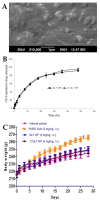Nanosystems for Brain Targeting of Antipsychotic Drugs: An Update on the Most Promising Nanocarriers for Increased Bioavailability and Therapeutic Efficacy
- PMID: 36840000
- PMCID: PMC9959474
- DOI: 10.3390/pharmaceutics15020678
Nanosystems for Brain Targeting of Antipsychotic Drugs: An Update on the Most Promising Nanocarriers for Increased Bioavailability and Therapeutic Efficacy
Abstract
Orally administered antipsychotic drugs are the first-line treatment for psychotic disorders, such as schizophrenia and bipolar disorder. Nevertheless, adverse drug reactions jeopardize clinical outcomes, resulting in patient non-compliance. The design formulation strategies for enhancing brain drug delivery has been a major challenge, mainly due to the restrictive properties of the blood-brain barrier. However, recent pharmacokinetic and pharmacodynamic in vivo assays confirmed the advantage of the intranasal route when compared to oral and intravenous administration, as it allows direct nose-to-brain drug transport via neuronal pathways, reducing systemic side effects and maximizing therapeutic outcomes. In addition, the incorporation of antipsychotic drugs into nanosystems such as polymeric nanoparticles, polymeric mixed micelles, solid lipid nanoparticles, nanostructured lipid carriers, nanoemulsions, nanoemulgels, nanosuspensions, niosomes and spanlastics, has proven to be quite promising. The developed nanosystems, having a small and homogeneous particle size (ideal for nose-to-brain delivery), high encapsulation efficiency and good stability, resulted in improved brain bioavailability and therapeutic-like effects in animal models. Hence, although it is essential to continue research in this field, the intranasal delivery of nanosystems for the treatment of schizophrenia, bipolar disorder and other related disorders has proven to be quite promising, opening a path for future therapies with higher efficacy.
Keywords: antipsychotics; bipolar disorder; brain targeting; intranasal delivery; nanocarriers; nanoparticles; nanosystems; psychotic disorders; schizophrenia.
Conflict of interest statement
The authors declare no conflict of interest.
Figures






Similar articles
-
Nanosystems, Drug Molecule Functionalization and Intranasal Delivery: An Update on the Most Promising Strategies for Increasing the Therapeutic Efficacy of Antidepressant and Anxiolytic Drugs.Pharmaceutics. 2023 Mar 20;15(3):998. doi: 10.3390/pharmaceutics15030998. Pharmaceutics. 2023. PMID: 36986859 Free PMC article. Review.
-
Nanosystems in nose-to-brain drug delivery: A review of non-clinical brain targeting studies.J Control Release. 2018 Jan 28;270:89-100. doi: 10.1016/j.jconrel.2017.11.047. Epub 2017 Dec 2. J Control Release. 2018. PMID: 29199063
-
Navigating the Nose-to-Brain Route: A Systematic Review on Lipid-Based Nanocarriers for Central Nervous System Disorders.Pharmaceutics. 2024 Feb 27;16(3):329. doi: 10.3390/pharmaceutics16030329. Pharmaceutics. 2024. PMID: 38543223 Free PMC article. Review.
-
Intranasal delivery of nanostructured lipid carriers, solid lipid nanoparticles and nanoemulsions: A current overview of in vivo studies.Acta Pharm Sin B. 2021 Apr;11(4):925-940. doi: 10.1016/j.apsb.2021.02.012. Epub 2021 Mar 13. Acta Pharm Sin B. 2021. PMID: 33996407 Free PMC article. Review.
-
Nose-to-brain delivery of lipid-based nanosystems for epileptic seizures and anxiety crisis.J Control Release. 2019 Feb 10;295:187-200. doi: 10.1016/j.jconrel.2018.12.049. Epub 2019 Jan 2. J Control Release. 2019. PMID: 30610952 Review.
Cited by
-
Research progress in brain-targeted nasal drug delivery.Front Aging Neurosci. 2024 Jan 17;15:1341295. doi: 10.3389/fnagi.2023.1341295. eCollection 2023. Front Aging Neurosci. 2024. PMID: 38298925 Free PMC article. Review.
-
[Development of a new platform for testing antiviral drugs using coronavirus-infected human nasal mucosa organoids].Nan Fang Yi Ke Da Xue Xue Bao. 2024 Nov 20;44(11):2227-2234. doi: 10.12122/j.issn.1673-4254.2024.11.20. Nan Fang Yi Ke Da Xue Xue Bao. 2024. PMID: 39623279 Free PMC article. Chinese.
-
Recent developments in intranasal drug delivery of nanomedicines for the treatment of neuropsychiatric disorders.Front Med (Lausanne). 2024 Sep 19;11:1463976. doi: 10.3389/fmed.2024.1463976. eCollection 2024. Front Med (Lausanne). 2024. PMID: 39364023 Free PMC article. Review.
-
Research Progress on Liposome Pulmonary Delivery of Mycobacterium tuberculosis Nucleic Acid Vaccine and Its Mechanism of Action.J Aerosol Med Pulm Drug Deliv. 2024 Oct;37(5):284-298. doi: 10.1089/jamp.2023.0025. Epub 2024 Apr 26. J Aerosol Med Pulm Drug Deliv. 2024. PMID: 38669118 Review.
-
Novel Therapeutic Hybrid Systems Using Hydrogels and Nanotechnology: A Focus on Nanoemulgels for the Treatment of Skin Diseases.Gels. 2024 Jan 6;10(1):45. doi: 10.3390/gels10010045. Gels. 2024. PMID: 38247768 Free PMC article. Review.
References
-
- Stȩpień-Wyrobiec O., Nowak M., Wyrobiec G., Morawiec E., Wierzbik-Strońska M., Staszkiewicz R., Grabarek B.O. Crossroad between current knowledge and new perspective of diagnostic and therapy of late-onset schizophrenia and very late-onset schizophrenia-like psychosis: An update. Front. Psychiatry. 2022;13:1025414. doi: 10.3389/fpsyt.2022.1025414. - DOI - PMC - PubMed
-
- Bai W., Liu Z.H., Jiang Y.Y., Zhang Q.E., Rao W.W., Cheung T., Hall B.J., Xiang Y.T. Worldwide prevalence of suicidal ideation and suicide plan among people with schizophrenia: A meta-analysis and systematic review of epidemiological surveys. Transl. Psychiatry. 2021;11:552. doi: 10.1038/s41398-021-01671-6. - DOI - PMC - PubMed
-
- Vos T., Lim S.S., Abbafati C., Abbas K.M., Abbasi M., Abbasifard M., Abbasi-Kangevari M., Abbastabar H., Abd-Allah F., Abdelalim A., et al. Global Burden of 369 Diseases and Injuries in 204 Countries and Territories, 1990–2019: A Systematic Analysis for the Global Burden of Disease Study 2019. Lancet. 2020;396:1204–1222. doi: 10.1016/S0140-6736(20)30925-9. - DOI - PMC - PubMed
Publication types
LinkOut - more resources
Full Text Sources

